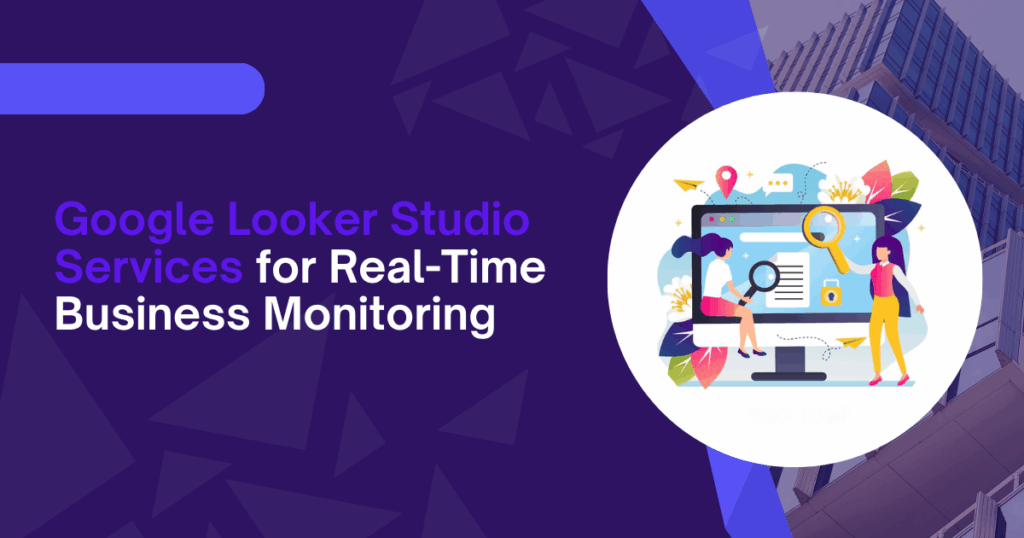Access to real-time data is now a necessity for businesses operating in dynamic markets. Companies that monitor operations as events happen gain an edge in decision-making, performance tracking, and strategic adjustments. Google Looker Studio, formerly known as Google Data Studio, plays a central role in real-time business intelligence. Through its customizable dashboards, real-time connectivity, and user-friendly design, Looker Studio enables organizations to visualize and act on data without delay. This article explores how Google Looker Studio Services help businesses implement real-time monitoring with technical precision.
What Is Google Looker Studio?
Google Looker Studio is a cloud-based data visualization tool that connects to multiple data sources. It provides interactive dashboards and real-time reports designed for operational visibility. Users can build, share, and collaborate on dashboards using drag-and-drop components, filters, charts, and calculated fields.
Key functions include:
- Real-time connection to databases and platforms
- Custom reporting across departments
- Visual display of performance indicators
- Collaborative editing and sharing
- Integration with Google Workspace and external systems
Why Real-Time Business Monitoring Matters
Real-time monitoring allows businesses to make decisions as data changes. Delayed reporting causes lost opportunities, slower issue resolution, and higher operational costs. With real-time visibility, businesses can:
- Detect issues immediately
- Monitor key metrics without waiting
- Improve productivity and allocation of resources
- Adjust strategy based on accurate, live information
This is especially important in environments like sales, logistics, finance, and IT operations, where fast response to change affects outcomes directly.
Core Advantages of Google Looker Studio Services
1. Real-Time Dashboard Views
Looker Studio connects to live data sources such as BigQuery, Google Sheets, SQL databases, and APIs. It supports automatic updates without requiring manual report generation. Dashboards refresh data continuously or at set intervals to reflect the current state of business activities.
2. Flexible and Custom Reporting
Looker Studio allows the design of custom KPIs and metrics relevant to specific departments. Whether tracking marketing ROI, order status, or financial metrics, reports are built to meet the unique needs of users. Visual options include line charts, bar graphs, geo maps, and tables—all of which update in real time.
3. Multi-Source Data Integration
Businesses often operate with fragmented data. Google Looker Studio Services offer integration with:
- Google Analytics
- Google Ads
- Google BigQuery
- MySQL / PostgreSQL / SQL Server
- CRMs like Salesforce
- Social media platforms via connectors
By combining data from different tools into a single dashboard, users get a unified view without switching between applications.
4. Enhanced Collaboration
Looker Studio supports multi-user editing and sharing. Dashboards can be restricted by user roles or departments. Shared reports ensure all teams operate with the same insights, reducing miscommunication. Updates are seen in real time, avoiding delays caused by version control issues.
5. Cost-Effective Implementation
Unlike other BI tools, Google Looker Studio offers a no-cost version with robust functionality. For organizations starting with BI, this reduces the entry barrier while still providing strong visualization and integration features. Paid enterprise solutions offer additional data governance and scaling capabilities.
Use Cases Across Industries
1. Retail Operations
A retail chain can track daily sales, top-performing products, and inventory gaps across regions. Store managers and marketing teams access dashboards showing promotions, sales revenue, and customer footfall without delay.
2. Finance and Accounting
Finance teams use Looker Studio to monitor expenses, revenue trends, and liquidity ratios. Real-time cash flow views assist CFOs in planning disbursements and investments accurately.
3. Manufacturing
Manufacturing managers monitor equipment uptime, defect rates, and production output through dashboards. Real-time data helps adjust workloads or shift schedules to maintain productivity.
4. Healthcare
Hospitals can use Looker Studio to track patient admissions, room availability, and lab processing times. Real-time information improves staff coordination and reduces patient wait times.
5. IT Operations
IT departments view system alerts, user activity, and ticket volumes through dashboards linked to service desk platforms. Teams resolve incidents faster with live insights into system status and performance metrics.
Key Features That Support Real-Time Monitoring
1. Scheduled Refresh and Live Connections
Reports can update in real time or at scheduled intervals (every 15 minutes, hourly, daily). When connected to platforms like BigQuery or Google Sheets, data reflects the latest state of operations without manual refreshing.
2. Filters and Controls
Users can apply real-time filters to see data by location, product, user segment, or time range. This interactivity allows deeper exploration without needing different reports for each parameter.
3. Data Blending
Google Looker Studio can merge data from different sources, enabling cross-functional analysis. For example, sales data from a CRM can be blended with customer engagement data from marketing platforms.
4. Custom Calculated Fields
Users can define new metrics directly in Looker Studio. This includes profitability calculations, growth percentages, or time-based comparisons—without altering the source data.
Measurable Benefits of Using Google Looker Studio
- Businesses using real-time dashboards report a 26% faster decision-making process
- Organizations tracking KPIs in real time reduce operational delays by 35%
- Sales teams using Looker dashboards increase conversion rates by 18% through quicker response
- Finance teams reduce reporting errors by up to 40% using consistent, shared dashboards
These benefits result from improved data accessibility, fewer manual tasks, and better internal visibility.
Technical Considerations for Implementation
To use Google Looker Studio Services effectively, consider these technical aspects:
- Use Google BigQuery for large datasets to enable fast queries
- Limit complex joins and calculated fields to reduce dashboard lag
- Implement access controls to protect sensitive data
- Monitor dashboard performance using built-in analytics
- Ensure source systems (e.g., Google Sheets or databases) are updated frequently
Organizations should work with experienced BI professionals or certified partners to ensure smooth deployment.
Common Challenges and Solutions
| Challenge | Solution |
| Dashboard latency | Use extracts or optimize data structure |
| Too many data sources | Blend sources at the database level before connecting to Looker |
| Inconsistent data | Define validation rules at the source and clean data before ingestion |
| User adoption issues | Provide training and create role-specific dashboards |
| Access control complexity | Use Google Workspace groups and viewer/editor roles |
Best Practices for Maximum Value
- Limit dashboard elements to essential KPIs to reduce clutter
- Use consistent naming for fields and charts
- Set up alerting mechanisms for threshold breaches
- Archive outdated reports to reduce resource load
- Conduct quarterly reviews to align dashboards with current goals
Conclusion
Google Looker Studio Services offer businesses a practical and effective solution for real-time monitoring. By connecting data sources, creating custom reports, and enabling instant collaboration, organizations gain a clear view of their operations at any moment. From small businesses to large enterprises, Looker Studio supports decision-making, reduces delays, and increases efficiency. Implementing this tool with the right strategy turns raw data into meaningful insights that drive results.






